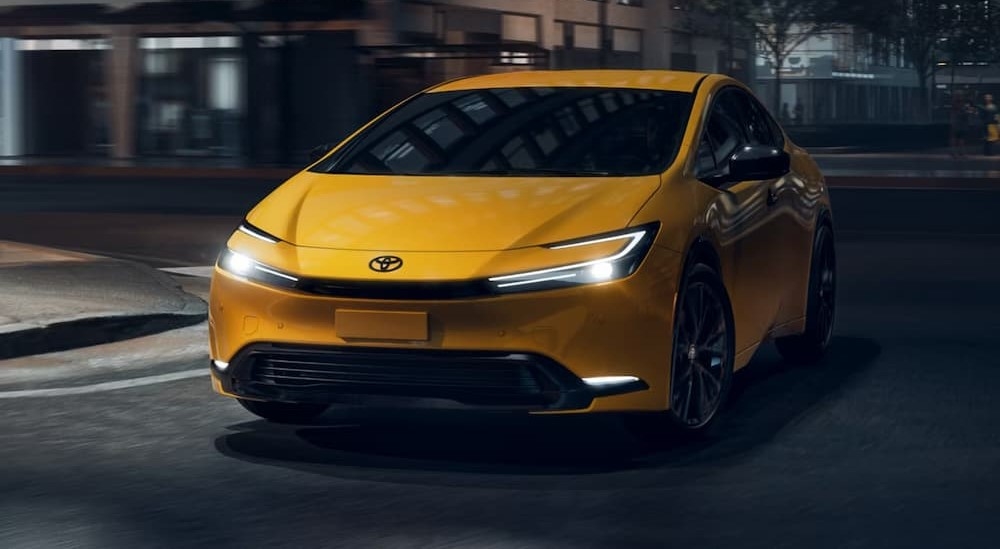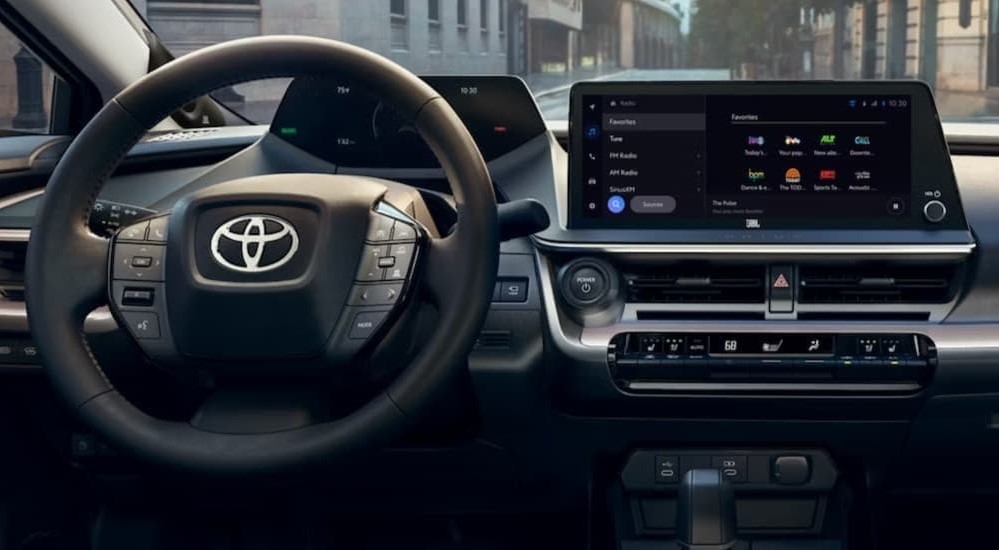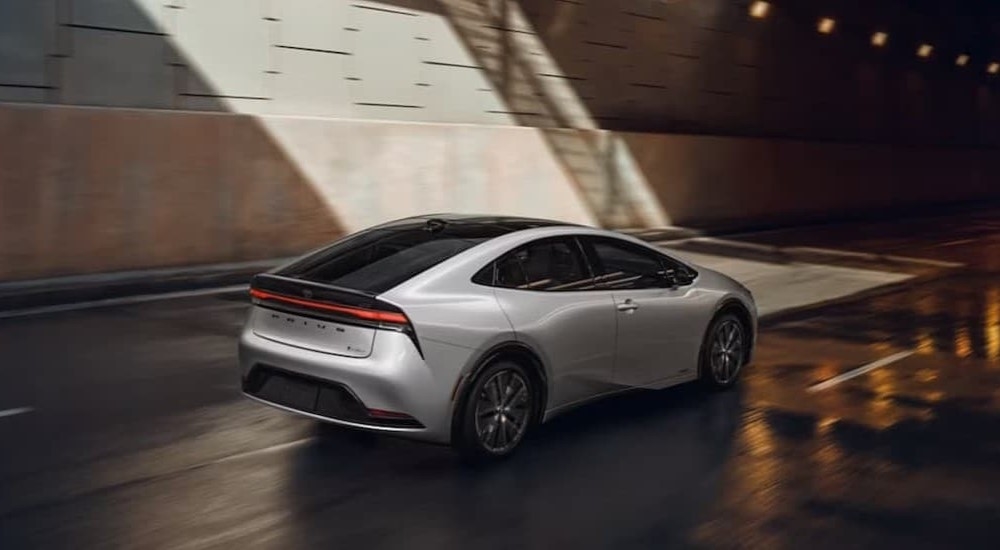The Toyota Prius ushered hybrids into the mainstream when it first debuted more than 20 years ago, and has continued to drive growth and innovation in the electrifying segment in the decades since. Now available as either a standard hybrid electric vehicle (HEV) or plug-in hybrid (PHEV), the Prius has weathered the influx of new models to remain the best-selling vehicle in the modern hybrid market.
Name recognition has certainly played a part in allowing the Prius to maintain its status, but it’s Toyota’s commitment to creativity and an ability to adapt to a changing consumer base that’s really responsible for keeping the Prius at the top of its game. The 2026 model year brings only modest changes to the popular hybrid, as Toyota introduced the latest fifth-generation Prius in 2023. However, there are still plenty of surprises in store when you visit Toyota of Bowling Green.
For example, the stylish Nightshade Edition continues to turn heads with its aggressive styling and unique hue in 2026; it’s been added to the PHEV model. Let’s walk through the highlights of the 2026 Toyota Prius and learn how the innovative sedan has become the bar against which all other hybrids are measured.
A Look at Engine Options
Once upon a time, hybrids were seen as an underpowered alternative to your typical gas-burning engine. A lot has changed since hybrid technology first entered the mainstream in the early 2000s, but few areas have seen more improvement than the engine itself. The Prius PHEV’s all-electric range marks the most obvious difference between the plug-in and pure hybrid versions, but there are a few other performance-related statistics drivers should be aware of before settling on a specific model.
Both hybrids are powered by the same 2.0-liter four-cylinder gas engine, but a larger 10.9-kWh battery pack and improved electric motors allow the PHEV to edge out the standard model by a slight margin. The PHEV manages to squeeze 220 hp from its gas engine and electric motors, while the traditional Prius tops out at 194 hp for the FWD powertrain and 196 hp for the AWD version.
Both models distribute their power through an electronic continuously variable automatic transmission (eCVT) that’s the perfect complement to the Prius’ fuel-saving ethos, ditching traditional gears for a more fluid approach that allows the Prius to stay in the most efficient power band. The Prius is no speed demon with a zero-to-60-mph time of 7.1 seconds, but the PHEV’s larger electric motors provide a slight boost in acceleration to reach cruising speed in 6.7 seconds. When it comes time to charge the battery, Prius PHEV drivers will only need to allot around four hours when connected to a 240-volt outlet, while the standard Prius tops off its battery by leveraging the gas engine and regenerative braking system.
Unbeatable Efficiency
While horsepower and zero-to-60-mph times are always useful metrics when comparing two models, most buyers are drawn to the Prius for its iconic efficiency. So how do the two sedans stack up in terms of pure range? Comparing an HEV and a PHEV is a classic case of apples and oranges, but luckily, the EPA has developed a helpful metric called miles-per-gallon equivalent (MPGe) that goes a long way towards simplifying the matter.
The regular Prius boasts an EPA-estimated 49 to 57 MPG in stop-and-go city conditions and 50 to 56 MPG on the highway while the Prius PHEV offers between 114 and 127 MPGe. That’s a pretty stark difference, but it doesn’t tell the whole story. The PHEV earns the nod when it comes to all-electric driving range, giving drivers the chance to cruise for up to 44 miles without tapping into their gas tank.
The non-PHEV Prius can’t operate solely on electric power, but it does offer a significant advantage in total range. The basic, FWD Prius can travel up to 644 miles on a single tank of gas, while the PHEV tops out at 600. No matter which model you choose, you’ll be saving lots of cash and skipping plenty of trips to the gas station with an average annual fuel cost of $725 for the PHEV and $875 for the standard model.
The Nightshade Edition Joins the Prius PHEV Lineup
From its very earliest days, the Prius was designed to make a statement. The car’s unique wedge shape and whisper-quiet low-speed operation allowed the hybrid to stand out and reflect the driver’s eco-conscious ethos when it first hit the market. However, Toyota is now taking a different approach in its attempt to distinguish the segment-defining car from the crowd.
The 2026 Prius PHEV will be graced with a Nightshade Edition trim that imbues the hybrid with a distinctive blacked-out aesthetic. The Nightshade Edition package first appeared on the 2019 Camry, Highlander, and 4Runner and has since been expanded to include other popular Toyota models, such as the Corolla, bZ4X, and Crown. Now available on both models, the Nightshade Edition trim sees the Prius infused with new, sporty details both inside and out.
The exterior adds 19-inch black-finished alloy wheels, black badging, door sills, door handles, and bumper trim, and can be customized with an exclusive yellow colorway dubbed Karashi that you won’t find on any other model, as well as Wind Chill Pearl and Midnight Black Metallic options. The Nightshade Edition even contributes a little performance-inspired upgrade to the interior with carbon fiber accents that lend the dashboard an edgy look. Best of all? The Nightshade Edition is easy on your wallet, adding just around $800 to the bottom line.
Infotainment and Safety
The Prius’ tech-forward approach isn’t limited to the cutting-edge components that you’ll find under the hood. Toyota has also prioritized the hybrid’s infotainment and safety technology to create a thoroughly modern Prius that’s sure to meet all of your digital desires. While the two lower trims are paired with an eight-inch touchscreen infotainment display, the other models can be equipped with a significantly larger 12.3-inch screen, which leaves plenty of room to navigate through the vehicle’s various functions, settings, and features.
If you prefer the hands-free approach, simply sit back, relax, and say “Hey, Toyota” to access the hybrid’s voice control system. From making calls and adjusting the climate control system to cueing up your favorite rush-hour playlist and navigating your way to unfamiliar locations, the voice control system gives drivers a new way to interact with the ride. Springing for a Drive Connect subscription further enhances the system’s slate of features, though the hybrid’s wireless Apple CarPlay and Android Auto smartphone connectivity offers a free alternative that serves a very similar role.
The Prius’ sophisticated slate of automotive technology also makes it one of the safest options on the road, with both the standard and PHEV models earning a stellar five-star rating from the National Highway Traffic Safety Administration for the 2025 model year (2026 ratings have not been published yet). In addition to its robust construction, the Prius also offers a generous array of advanced driver assistance systems (ADAS), including Full-Speed Range Dynamic Radar Cruise Control, Lane Departure Alert, a Blind Spot Monitor, a Pre-Collision System with Pedestrian Detection, and optional add-ons such as Front and Rear Parking Assist.
Embrace Hybrid Power With the 2026 Toyota Prius
Toyota of Bowling Green has been connecting Kentucky drivers with some of the industry’s best cars, trucks, and SUVs for more than 40 years. A lot has changed over the last four decades, especially when it comes to hybrid models like the Toyota Prius. We’ve kept up with the times and expanded our own expertise to learn the ins and outs of these exciting new vehicles.
We know that making the switch to a hybrid can be a little intimidating for those accustomed to the world of gas-powered models, but we’re here to walk you through the process and answer any questions you might have about performance, range, or charging. The 2026 Prius might just be the best version yet, and the new Nightshade Edition on the PHEV model is sure to prove tempting for those who want to add a little extra style to their daily driver. If you’re ready to experience the future of automotive sustainability, Toyota of Bowling Green is here to help.


